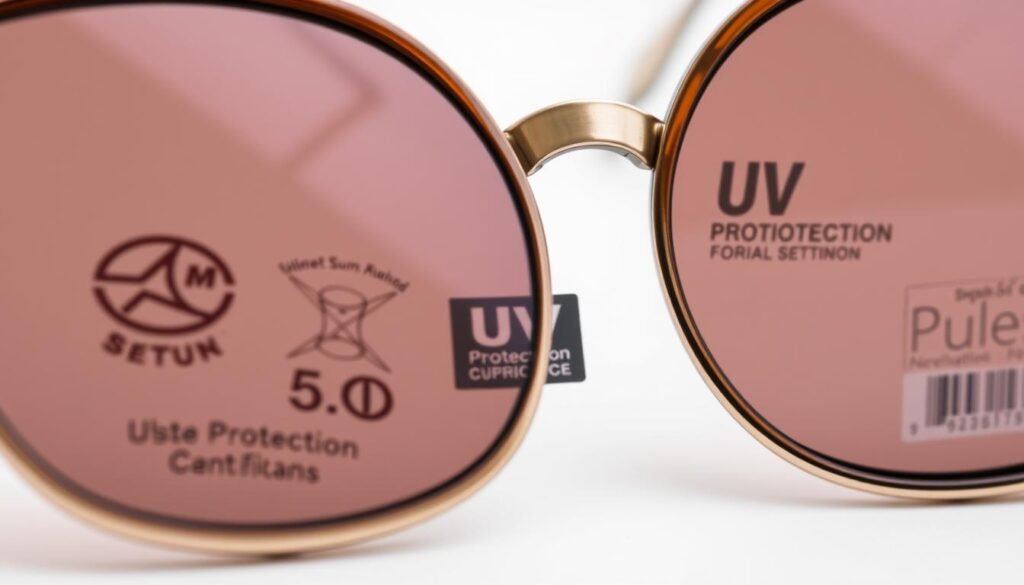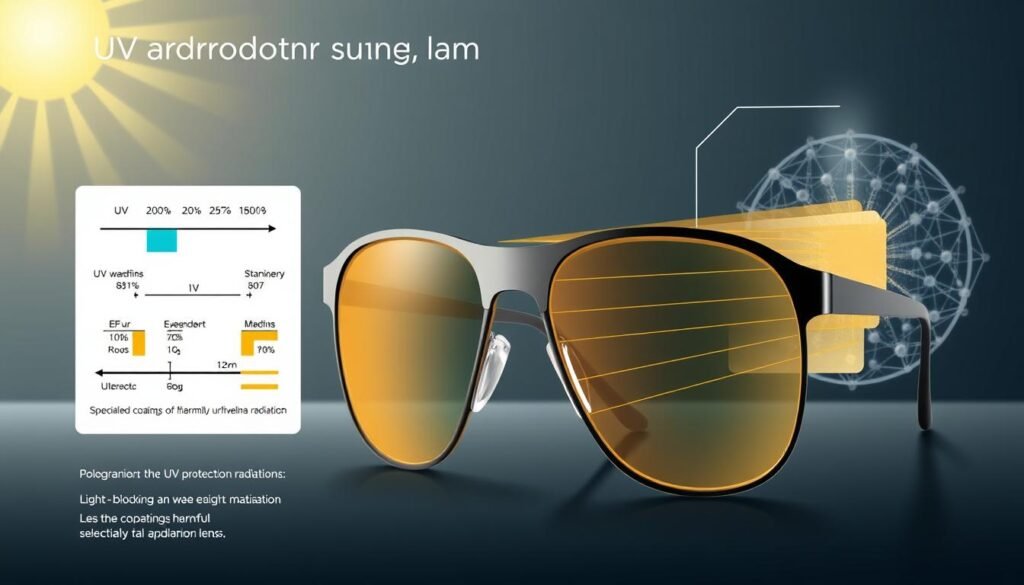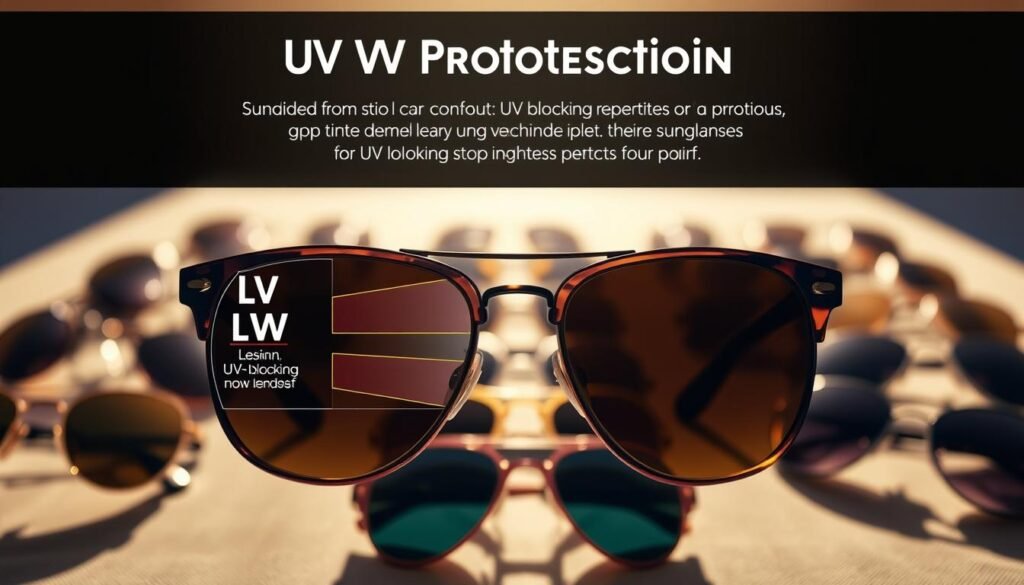Welcome to your go-to resource for choosing eyewear that does more than elevate your look. While stylish shades turn heads, their real value lies in safeguarding your vision. This guide cuts through the noise to help you prioritize what truly matters.
Many treat eyewear as purely aesthetic accessories. However, the right pair serves as armor against UV rays, glare, and environmental stressors. We’ll explore how features like lens technology and frame durability impact both safety and comfort.
Whether you’re shopping for beach days, mountain hikes, or urban adventures, this breakdown covers critical factors. You’ll learn why materials matter, how fit affects performance, and which certifications guarantee genuine protection. No more guessing games at the store.
Key Takeaways
- UV-blocking capabilities are non-negotiable for eye health
- Lens material determines clarity and impact resistance
- Proper fit prevents slippage during activities
- Frame quality affects longevity and comfort
- Style should complement – not compromise – functionality
By the end, you’ll confidently select eyewear that merges smart engineering with your personal flair. Let’s dive into the details that separate mediocre pairs from lifelong companions.
Overview: Why Sunglasses Are Essential for Eye Health
Your eyes face invisible threats every time you step outside. Quality eyewear acts as a shield against environmental hazards while expressing personal style. Let’s explore why prioritizing health features creates smarter fashion choices.
More Than Accessories
Sunglasses serve two critical roles: medical guardians and style enhancers. While trendy frames catch attention, their UV-blocking technology prevents irreversible damage. Think of them as sunscreen for your vision system.
Research shows 50% of lifetime UV exposure occurs by age 20. Daily protection habits matter more than occasional use during beach trips. Harmful rays penetrate clouds and bounce off surfaces like water or concrete, requiring constant defense.
Hidden Dangers, Real Solutions
Prolonged sun exposure without proper coverage leads to:
| Condition | Cause | Prevention |
|---|---|---|
| Cataracts | UV-induced lens clouding | Full-spectrum lenses |
| Macular Degeneration | Retina damage | Wrap-around designs |
| Photokeratitis | Corneal sunburn | Polarized coatings |
The delicate skin around eyes ages 10x faster than other facial areas. Quality frames with broad coverage reduce wrinkle risks and shield against windborne debris. True style combines flattering shapes with life-preserving features.
Regular eyewear use prevents 90% of UV-related vision issues according to optometrists. Pair your look with certified protection – your future self will thank you.
Exploring the Most Important Thing When Buying Sunglasses
Smart shoppers know eyewear decisions impact both vision and style. Let’s break down what separates effective sun gear from risky fashion statements.

Non-Negotiable Safety Features
100% UV protection remains the foundation of any worthy pair. Look for labels stating “UV400” or “100% UVA/UVB protection” – these block harmful rays up to 400 nanometers. “A common myth is that darker lenses block more UV rays,” notes optician Laura Chen. “The tint just reduces visible light—it’s the invisible coating that matters.”
Quality indicators go beyond price tags. Seek these marks of approval:
- ANSI Z80.3 (American safety standard)
- CE mark (European compliance)
- Polarized certification (for glare reduction)
Tailored Performance Needs
Your activities dictate lens specs. Urban commuters benefit from anti-reflective coatings, while boaters need polarized options. Consider this quick guide:
| Activity | Lens Feature |
|---|---|
| Daily Use | Medium tint + UV400 |
| Sports | Polycarbonate + wraparound |
| Driving | Polarized + gradient |
| Outdoor Work | Mirrored + impact-resistant |
For vision correction needs, modern prescription sunglasses offer crystal clarity without compromising protection. Many brands now provide Rx options with the same protective coatings as regular models.
Frame shape plays dual roles in style and function. Oval faces rock wayfarers, while square jaws shine in round frames – but always ensure adequate side coverage. As you choose your next pair, remember: true style never sacrifices safety.
Understanding UV Protection for Maximum Eye Safety
The science behind UV protection separates life-saving eyewear from risky fashion accessories. Let’s break down how light filtration works and why certification matters more than lens color.

Full UVA and UVB Coverage Explained
Quality protection lenses block all rays below 400 nanometers – the complete spectrum of UVA and UVB light. This invisible shield stops 99-100% of harmful radiation, including blue-violet wavelengths that contribute to macular degeneration.
| Certification | Meaning | Verification Tip |
|---|---|---|
| UV400 | Blocks rays ≤400 nm | Check packaging labels |
| CE Mark | Meets European standards | Look for engraved symbol |
| ANSI Z80.3 | U.S. impact resistance | Ask for test documentation |
Dark tints create a dangerous illusion. “Your pupils expand behind dark lenses, letting in 5x more UV rays if they’re uncoated,” explains optometrist Dr. Rachel Torres. Clear lenses with proper coatings actually provide safer sun defense than untreated dark shades.
Risks of UV Exposure Without Protection
Every sunny day adds to your lifetime UV damage tally. Consider these eye conditions linked to sun exposure:
- Cataracts develop 10 years earlier in unprotected eyes
- Eyelid skin cancer rates double for outdoor workers
- Snow blindness can occur in 2 hours of reflected glare
Cloudy days still deliver 80% of UV radiation. Rays bounce off water, sand, and even concrete – making urban environments just as risky as beaches. For year-round safety, choose protection lenses with verified 400 nm blocking, regardless of tint level.
Exploring Lens Technologies and Coatings
Modern sunglasses transform sunlight management into a science. Advanced lens engineering now offers solutions for every environment, merging technical precision with user comfort.
Polarized Lenses and Glare Reduction
Polarized lenses act like microscopic blinds for your eyes. They filter horizontal light waves bouncing off flat surfaces – think wet roads or lake surfaces. This cuts glare by up to 90%, revealing hidden details beneath water or snow.
Anglers spot fish easier in shimmering streams. Drivers see road hazards faster without blinding reflections. “It’s like wiping fog off a window,” says marine photographer Eli Martinez. Suddenly, everything below the surface becomes visible.”
Adaptive, Mirrored, and Gradient Tint Options
ZEISS AdaptiveSun lenses revolutionize light management. Starting at 60% tint indoors, they darken to 97% in bright sun – perfect for skiers moving between shadowy slopes and sunlit peaks. No more switching glasses between environments.
Mirrored coatings aren’t just stylish. These vapor-deposited layers reflect extra light in desert or alpine conditions. Check their performance perks:
| Coating Type | Best For | Light Reduction |
|---|---|---|
| Blue Mirror | Snow Sports | 15% extra |
| Gold Flash | Beach Days | 20% reflection |
| Silver Gradient | Driving | Top-down shading |
Lens colors serve specific needs. Grey maintains true colors during bright days, while amber boosts contrast for twilight hikes. Remember: polarized lenses might make phone screens look darker. Choose standard coatings if you’re glued to devices outdoors.
Evaluating Frame Materials, Fit, and Style
The perfect pair balances protection and personality. Your eyewear’s foundation starts with smart frame material choices and precise fit – factors that determine comfort and performance.
Choosing the Right Material for Durability
Metal frames shine for their sleek profiles and lightweight feel. Ideal for daily wear, they resist bending but may dent during intense activities. Plastic options offer bold colors and affordability, though prolonged sun exposure can weaken their structure.
Active users favor nylon frames. This flexible material bends without breaking, making it ideal for sports or outdoor adventures. Some brands blend materials, pairing metal hinges with nylon temples for hybrid durability.
Achieving a Comfortable and Secure Fit
Properly fitting glasses stay put during head turns or quick movements. Nose pads should distribute weight evenly without pinching. Temples must grip gently behind ears – too tight causes headaches, too loose invites slippage.
Oversized styles shield more skin from UV damage. Wrap-around designs block side glare while maintaining peripheral vision. Test fit by smiling: lenses shouldn’t touch cheeks. Your ideal pair feels like a natural extension of your face.

